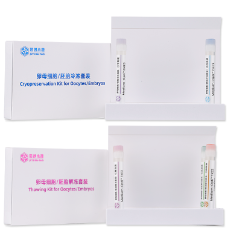What is the principle behind cell cryopreservation solution to protect cells from damage at low temperatures?
Date:2024-10-28 20:08:14
Views:0
The protection of cells from damage at low temperatures by cell cryopreservation solution is mainly based on the following principles:
1、 Lowering the freezing point and controlling ice crystal formation
Cell cryopreservation buffer contains cryoprotectants such as glycerol and dimethyl sulfoxide (DMSO). These substances can lower the freezing point of the solution, allowing cells to maintain a liquid environment at lower temperatures. For example, the addition of DMSO can cause the solution to freeze only at temperatures below the freezing point of pure water.

More importantly, they can inhibit the formation of ice crystals. During the freezing process, if a large amount of ice crystals form inside the cells, the expansion of the ice crystals can cause the rupture of the cell membrane and organelle membrane, resulting in irreversible damage to the cells. Cryoprotectants can slow down the formation rate of ice crystals and allow them to grow in smaller sizes. They interfere with the hydrogen bonds between water molecules, preventing them from aggregating in an orderly manner to form large ice crystals, thereby reducing mechanical damage to cell structure.
2、 Maintain osmotic pressure balance
When cells are in a low-temperature environment, the osmotic pressure inside and outside the cell changes. The components of cell cryopreservation solution can regulate osmotic pressure to match the osmotic pressure inside the cells. If the osmotic pressure outside the cell is too high, a large amount of water inside the cell will seep out, leading to cell shrinkage; On the contrary, if the extracellular osmotic pressure is too low, the cells will absorb water, expand, and rupture.
The components in the freezing solution can maintain the normal morphology and physiological function of cells during freezing and recovery by regulating the ion concentration inside and outside the cells and the distribution of water molecules. For example, some salt ions and carbohydrate substances play an important role in this process, as they can form appropriate concentration gradients inside and outside the cell, ensuring cell stability.
3、 Protecting cellular structure and function
The cell membrane is the first line of defense for cells and is susceptible to damage during freezing. The components in cell cryopreservation solution can interact with the cell membrane, stabilizing the lipid bilayer structure of the cell membrane. Some protective agents can be embedded between phospholipid molecules on the cell membrane to prevent the membrane structure from breaking due to temperature changes and ice crystal compression.
Cryopreservation solution also has a protective effect on intracellular organelles. By reducing the damage of ice crystals to organelles such as mitochondria and endoplasmic reticulum, and maintaining their integrity, normal metabolism and physiological activities within cells can be maintained. After recovery, cells can quickly restore normal functions such as energy metabolism and protein synthesis.




